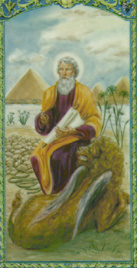We ask you, urgently: don't scroll past this
Dear readers, Catholic Online was de-platformed by Shopify for our pro-life beliefs. They shut down our Catholic Online, Catholic Online School, Prayer Candles, and Catholic Online Learning Resources essential faith tools serving over 1.4 million students and millions of families worldwide. Our founders, now in their 70's, just gave their entire life savings to protect this mission. But fewer than 2% of readers donate. If everyone gave just $5, the cost of a coffee, we could rebuild stronger and keep Catholic education free for all. Stand with us in faith. Thank you.Help Now >
St. Mark
Facts
Patron: of notaries, Venice, Barristers
Birth: 1st Century
Death: April 25, 68 AD
Author and Publisher - Catholic Online
Printable PDF of St. Mark
Shop St. Mark

Much of what we know about St. Mark, the author of the Second Gospel, comes largely from the New Testament and early Christian traditions. Mark the Evangelist is believed to be the 'John Mark' referred to in the Acts of the Apostles, the history of the early Church found in the Canon of the New Testament.
He was the son of Mary of Jerusalem (Acts 12:12) whose home became a meeting place for the apostles. He is also the cousin of St. Barnabas (Colossians 4:10), a Levite and a Cypriot.
Mark joined St. Paul and St. Barnabas on their first missionary journey to Antioch in 44 A.D. When the group reached Cyprus, Christian tradition holds that Mark left them and returned to Jerusalem, possibly because he was missing his home (Acts 13:13). This incident may have caused Paul to question whether Mark could be a reliable missionary. This created a disagreement between Paul and Barnabas and led Paul to refuse Mark's accompaniment on their second journey to the churches of Cilicia and the rest of Asia Minor.
However, it can be assumed the troubles between Paul and Mark did not last long, because when Paul was first imprisoned, Mark, who was at the time in Rome with plans of visiting Asia Minor, visited him as one of his trusted companions (Col 4:10).
Mark's hopes to visit Asia Minor were most likely carried out, because during Paul's second captivity and just before his martyrdom, Paul wrote to Timothy at Ephesus advising him to "take Mark and bring him with you [to Rome], for he is profitable to me for the ministry" (2 Timothy 4:11). If Mark returned to Rome at this time, he was probably there when Paul was martyred.
According to Christian tradition, Mark also held a close relationship with St. Peter, who referred to Mark has 'his son' in his letter addressed to a number of churches in Asia Minor (1 Peter 5:13). Clement of Alexandria, Irenaeus and Papias all indicate that Mark was an interpreter for Peter.
Although Papias states Mark had not personally heard the Lord speak firsthand and, like Luke, Mark was not one of the twelve apostles, some believe Mark was likely speaking of himself when he wrote the description of Jesus' arrest in Gethsemani. "Now a young man followed him wearing nothing but a linen cloth about his body. They seized him, but he left the cloth behind and ran off naked" (Mark 14:51-52).
St. Mark lived for years in Alexandria, where he died as a martyr while being dragged through the streets.
Mark's Gospel was probably written between 60 and 70 A.D., and was based upon the teachings of St. Peter. It is believed Mark provided both Luke and Matthew with basic sources for their Gospel's.
He was probably the first bishop of Alexandria, Egypt and the founder of the Church of Alexandria, although he is not mentioned in connection to the city by either Clement of Alexandria nor by Origen.
In 828, relics of St. Mark were stolen from Alexandria and taken to Venice, Italy. There they are enshrined in a beautiful cathedral dedicated to the saint.
St. Mark's symbol is a winged lion. This is believed to be derived from his description of St. John the Baptist, as "a voice of one crying out in the desert" (Mark 1:3). The wings come from Ezekiel's vision of four winged creatures as the evangelists.
He is often depicted as writing or holding his Gospel. He is sometimes shown as a bishop on a throne or as a man helping Venetian sailors.
St. Mark is the patron saint of Venice. His feast day is celebrated on April 25.
Join the Movement
When you sign up below, you don't just join an email list - you're joining an entire movement for Free world class Catholic education.
An Urgent Message from Sister Sara – Please Watch
- Advent / Christmas
- 7 Morning Prayers
- Mysteries of the Rosary
- Litany of the Bl. Virgin Mary
- Popular Saints
- Popular Prayers
- Female Saints
- Saint Feast Days by Month
- Stations of the Cross
- St. Francis of Assisi
- St. Michael the Archangel
- The Apostles' Creed
- Unfailing Prayer to St. Anthony
- Pray the Rosary
![]()
Copyright 2026 Catholic Online. All materials contained on this site, whether written, audible or visual are the exclusive property of Catholic Online and are protected under U.S. and International copyright laws, © Copyright 2026 Catholic Online. Any unauthorized use, without prior written consent of Catholic Online is strictly forbidden and prohibited.
Catholic Online is a Project of Your Catholic Voice Foundation, a Not-for-Profit Corporation. Your Catholic Voice Foundation has been granted a recognition of tax exemption under Section 501(c)(3) of the Internal Revenue Code. Federal Tax Identification Number: 81-0596847. Your gift is tax-deductible as allowed by law.









